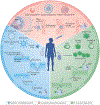Base editing: advances and therapeutic opportunities
- PMID: 33077937
- PMCID: PMC7721651
- DOI: 10.1038/s41573-020-0084-6
Base editing: advances and therapeutic opportunities
Abstract
Base editing - the introduction of single-nucleotide variants (SNVs) into DNA or RNA in living cells - is one of the most recent advances in the field of genome editing. As around half of known pathogenic genetic variants are due to SNVs, base editing holds great potential for the treatment of numerous genetic diseases, through either temporary RNA or permanent DNA base alterations. Recent advances in the specificity, efficiency, precision and delivery of DNA and RNA base editors are revealing exciting therapeutic opportunities for these technologies. We expect the correction of single point mutations will be a major focus of future precision medicine.
Conflict of interest statement
Competing interests
A.C.K. is a member of the scientific advisory board (SAB) of Pairwise Plants, and is an equity holder for Pairwise Plants and Beam Therapeutics. I.M.S. is an employee and shareholder of Beam Therapeutics. G.W.Y. is co-founder, member of the Board of Directors, on the SAB, equity holder and paid consultant for Locana and Eclipse BioInnovations. G.W.Y. is a visiting professor at the National University of Singapore. A.C.K.’s and G.W.Y.’s interests have been reviewed and approved by the University of California, San Diego in accordance with its conflict of interest policies. The authors declare no other competing financial interests.
Figures




References
Publication types
MeSH terms
Grants and funding
LinkOut - more resources
Full Text Sources
Other Literature Sources
Medical
Research Materials

